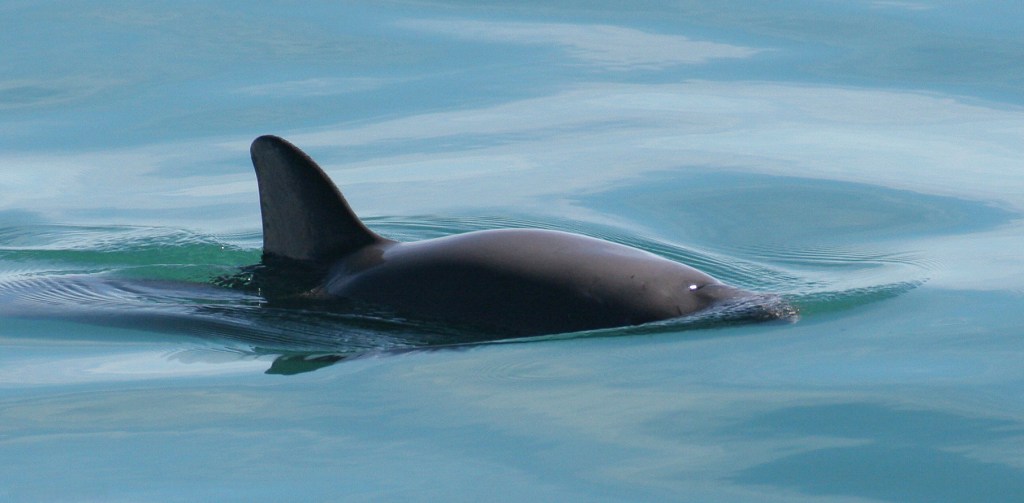The world’s population of vaquitas, a small porpoise that lives in the Upper Gulf of California, consists of only 12 individuals (and possibly fewer). It is the world’s most endangered marine mammal, and one of the most endangered creatures on earth.
The population trend for this secretive creature strongly suggests time is running out. Just twenty years ago, there were 600 vaquitas. In 2015, there were 60 remaining, and in 2017, 30.
The vaquitas have always lived only in the Mexico’s Upper Gulf. Their habitat could support many more porpoises. While the Colorado River that flows into the Gulf has been altered significantly, the river has not had adverse impacts on porpoise habitat. The porpoises are not suffering due to warmer water temperatures or pollution. People don’t eat them. There is no market for them.
The problems they face appear to be solvable ones. But that’s an illusion.
One of the challenges facing the vaquita is that many don’t know the creature or its plight. Because of its secretive nature, it is extremely difficult to photograph or capture on video. That, in turn, means it isn’t featured in magazine articles, on the news or in nature documentaries.
Even many people who live near the vaquita’s range question its existence, treating it somewhat like Bigfoot.
The vaquita needs people to tell its story, people like Brooke Bessesen in her wonderful, heartbreaking new book, Vaquita: Science, Politics and Crime in the Sea of Cortez.
 Bessesen set out to tell a straightforward story, for vaquitas are being killed as bycatch in commercial fisheries. They drown when they are caught in nets, but the nets are not set for them. The good news? There are ways to eliminate or reduce bycatch. Researchers know where the vaquitas are, so nets can be prohibited there. And there are alternative ways for commercial fishers to earn incomes.
Bessesen set out to tell a straightforward story, for vaquitas are being killed as bycatch in commercial fisheries. They drown when they are caught in nets, but the nets are not set for them. The good news? There are ways to eliminate or reduce bycatch. Researchers know where the vaquitas are, so nets can be prohibited there. And there are alternative ways for commercial fishers to earn incomes.
This sounds, at first, like a solvable problem. But as Bessesen writes:
“I must admit that I was unprepared for the twists and turns of the journey, the obscurities and contradictions that at times made the experience of researching vaquita as out of control, nerve wracking, and thorny as skidding across the barren sand bed of the Colorado River.”
Then she adds: “Above all, I learned that conservation is a messy business.”
And this example is even messier than most. Why can’t the issue of bycatch simply be addressed? Because the targeted fish is totoaba (a kind of croaker), itself an endangered species. It is being poached for its swim bladder, which is made into fish maw soup, a Chinese dish with supposed curative properties “including improved skin complexion and circulation.”
This soup fuels a huge black market for endangered fish. The gillnets set for those fish indiscriminately catch and kill sharks, rays, dolphins and whales. And vaquitas. At this point, every single vaquita counts. But they’re dying, one by one, in the nets.
Given the significant money to be made in catching totoaba, drug cartels and corrupt officials have become involved. Enforcement has often been weak to non-existent. Payment programs aimed at paying fishers not to fish end up being abused. New technology exists that would basically eliminate bycatch, but the Mexican environmental ministry won’t approve them for use.
Vaquita is beautifully written, but it is not an easy one to read. Several times I had to put it down, distressed and depressed by the situation. I appreciate that Bessesen doesn’t shy from showing her own emotions, her own distress. But she keeps working anyway, spending time with researchers deploying acoustic monitors, members of Sea Shepherd patrolling seas for poachers, with artists trying to raise awareness in their local communities. She talks to fishers and government officials and community members.
She has great empathy for the nuances. As she writes: “Obviously, fishermen should not be allowed to obliterate entire ecosystems. Neither should conservation measures collapse communities. But where, exactly, is the midpoint? Where on the sliding scale is compromise deemed fair?”
Conservationists wrestle with this. Bessesen wrestles with this. And she maintains hope. But the harsh fact is this: There are 12 of these animals left on earth, maybe fewer. It’s deemed the time for extreme measures, like capturing vaquitas for captive breeding. But when that was attempted, the capture resulted in the death of the vaquita.
Time is running out, and it doesn’t look good.

What will we learn? Perhaps that we’re guilty of endangered species procrastination. Think of it in terms of general procrastination. Say you have a report (or other large, complicated project) due in two months. You know you should start now, but you have two full months.
With each passing day, you have more work and you’re more stressed. At a certain point, the scope of the problem is overwhelming. Then you realize the report is due the next day, and you stay up all night, call in colleagues, and have panic attacks. But it doesn’t matter. You waited too long.
The same basic process played out with vaquitas. In 1997, with the population below 600, conservationists recognized a problem but there was a sense that a solution would eventually be found. Then the population dropped below 300, and everyone realized that something had to be done, but what? With each drop in the population, the urgency of the situation became more apparent, until the point it became overwhelming.
With 12 animals, there are desperate measures being contemplated to save the animal, but it seemingly will take something miraculous for anything to work.
The vaquita may very well die on our watch. What’s next? While anyone reading this blog knows the plight of black rhinos and tigers, there’s a sense that we’ll somehow figure out how to save them. And yet, the numbers keep dropping, dropping, dropping.
As Bessesen asks, “What will we do, not do?” How we answer that question determines how many times we will keep repeating stories like the vaquita’s in the years ahead.




If these gorgeous creatures only live in one specific are, they should declare the part of the habitat they live in a sanctuary, off limits to the fisherman who accidentally entrap them. Why aren’t the poachers punished for breaking the laws? A species this endangered should be of top priority, taken seriously enough to strictly penalize the poachers, and the area heavily policed To make sure the law is enforced. This is much too critical to not take extreme measures.
Man is always the problem for endangered species, specifically greedy ones who care more about making money than they do our ecosystem.
Muchos, muchos kudos -thanks- and bravos, for Sea Shepherd, whose boats and crew actually did something years ago (and are still doing so), when NOAA, and all the other scientific organizations kept counting animals and talking, counting animals and talking, counting animals and talking, while the numbers dropped amazingly from 500 in a few short years, to 12 now (estimated). Why keep talking and counting? Sea Shepherd actually put boats in the sea of Cortez and pulled up nets and chased down, with drones, the poachers. There have been no poachers put in jail, fined or convicted – zero – by the Mexican Government, so obviously, they are unable to enforce any law they have written to placate the international conservation community. I wonder how ignorant these conservationists are regarding human behavior and politics in country such as Mexico?
At this time, action is needed more than any amount of scientists who can count animals with high tech equipment. Also, it must be said, that the parties that were involved with creating the plan to pay fishers not to fish, and other attempts by the Mexican govt., don’t know much about how the world works. Have any of these people visited Baja or know anything about how a fisher village would behave when paid not to fish? It’s laughable if it wasn’t something to cry about. Please check out culture before relying on the types of laws implemented by Mexico to ‘save’ this species. I believe the scientists and conservation groups involved with these decisions over the last 5 years are extremely naive, just too innocent about how politics and people work. The vaquita will pay the price.
This is truly heartbreaking. It’s hard to watch an endangered species slowly vanishing before our eyes .
You must have poured your heart out in this book, Brooke! I would love to read it!